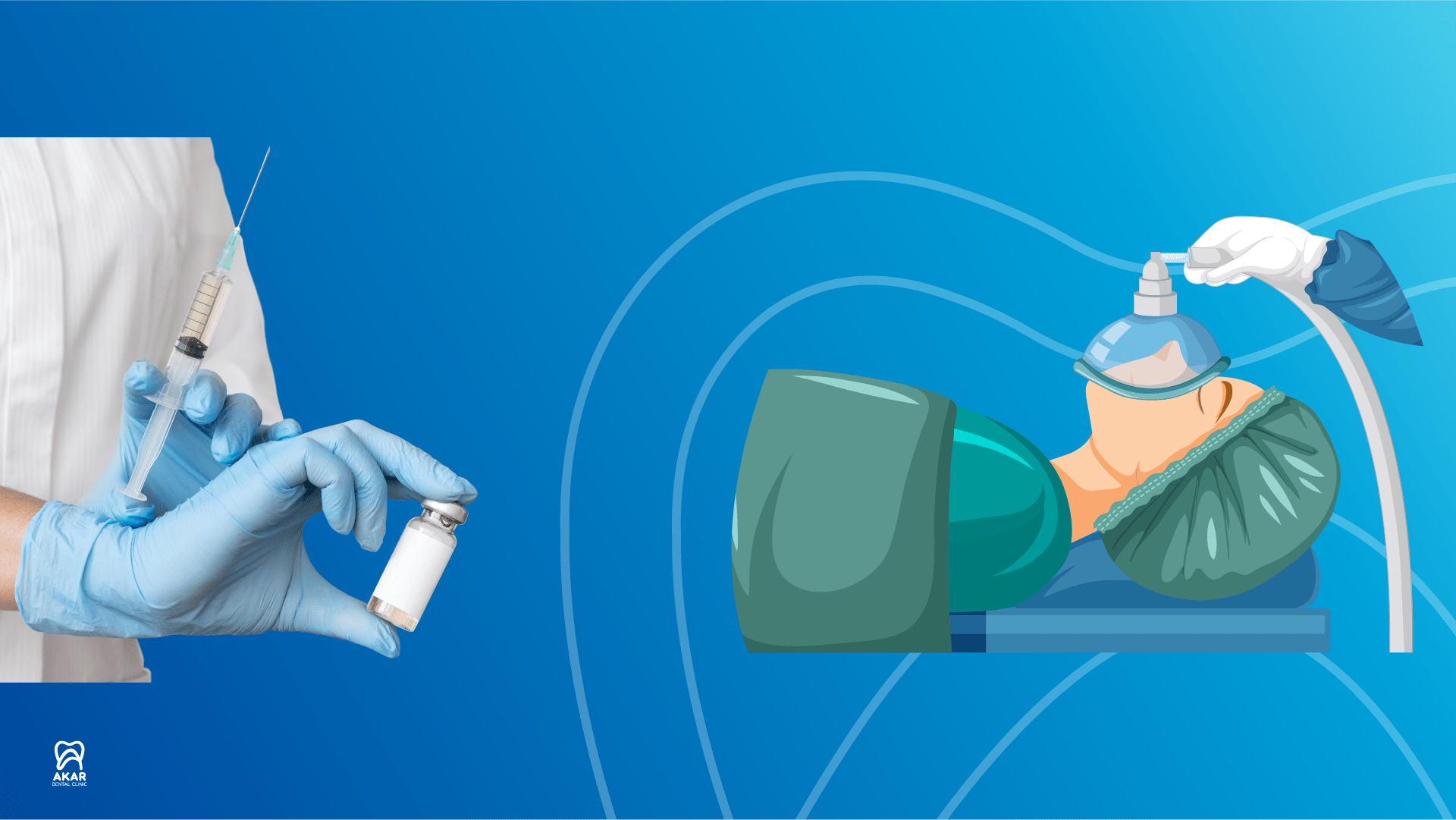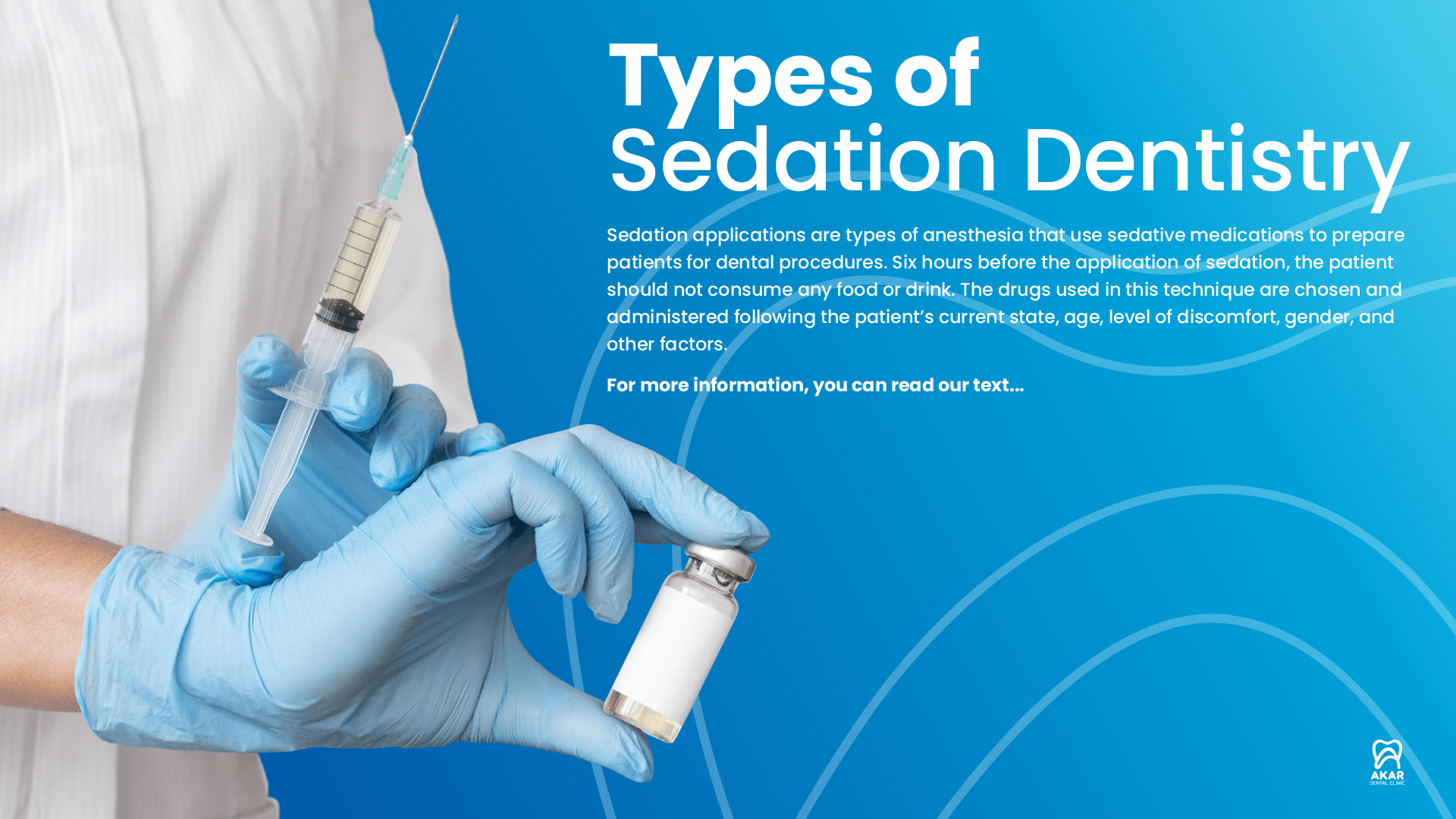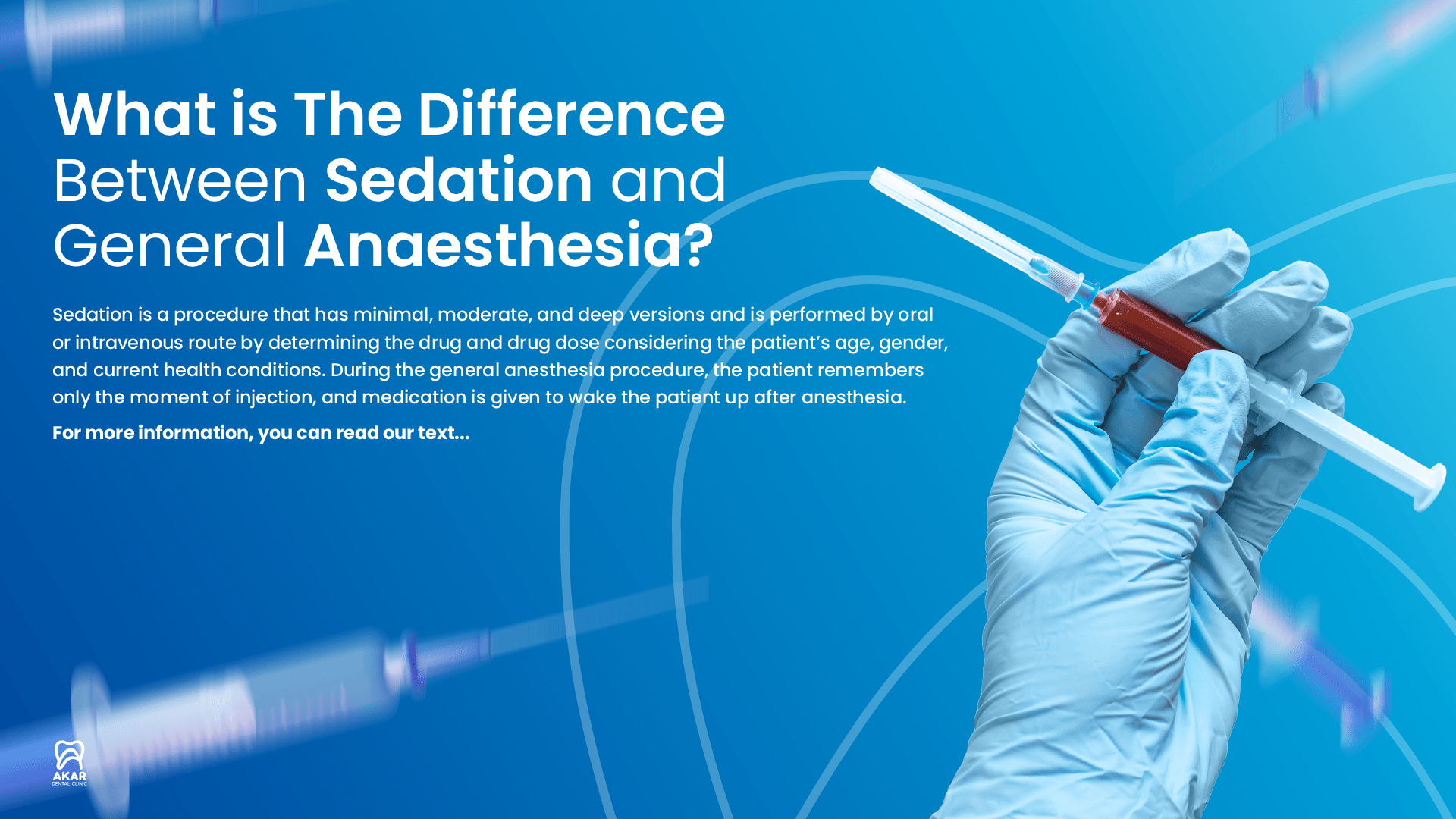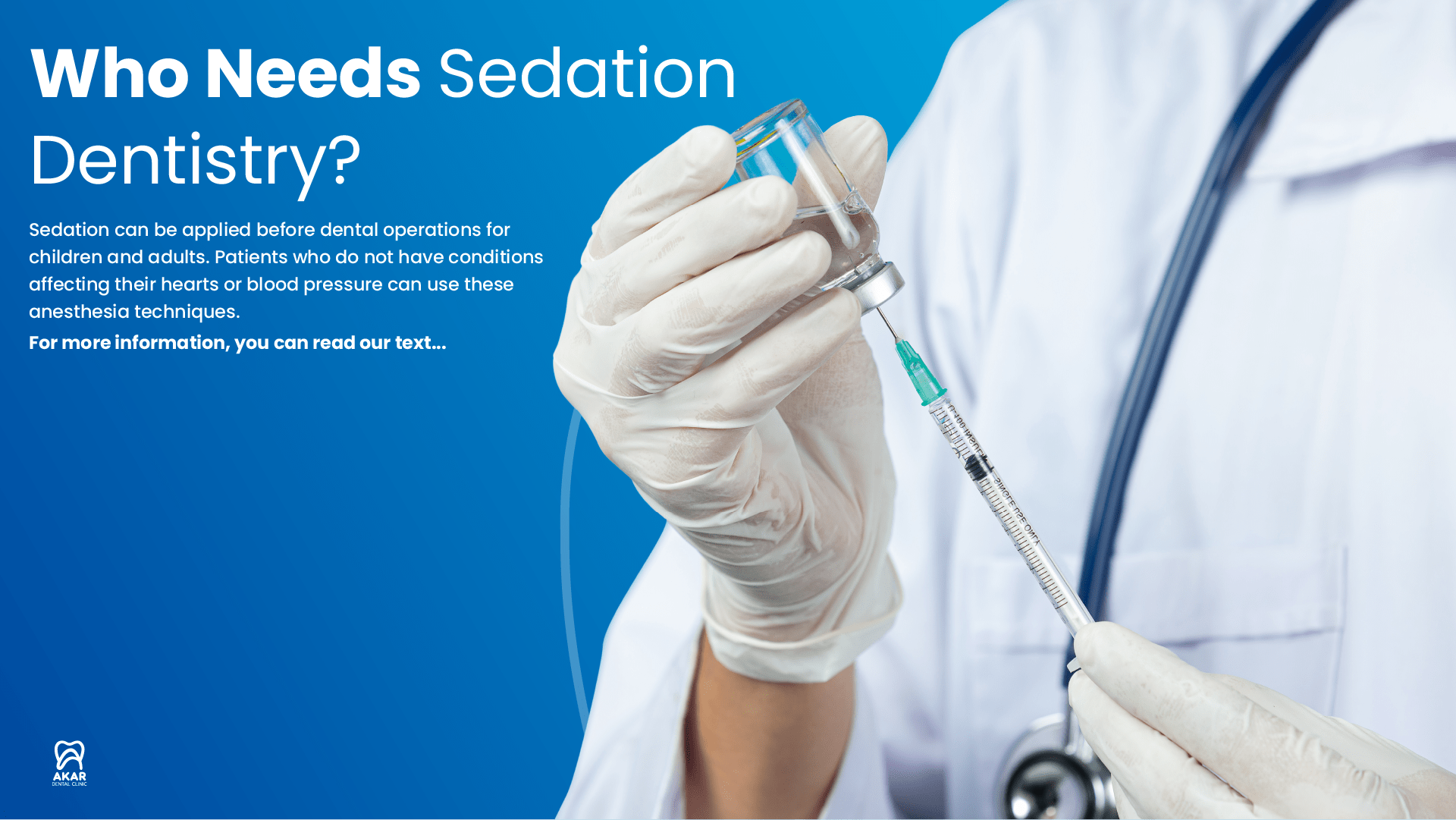

The sedation anesthesia technique used in dental operations ensures that the patient does not feel anything by raising the pain threshold. In the procedures performed in our clinic, we aim to eliminate our patients’ concerns about the treatment and to eliminate stress.
Because the reduction of the stress factor makes the operation more comfortable for the patient and provides a more comfortable working environment for the dentist by preventing unwanted reflexes during the procedure, thus, the success rate of the process also increases in direct proportion, so we guarantee success in all the treatments we perform in our clinic.
What is Sedation?
 The dental conscious sedation anesthesia technique used in surgical operations eliminates the patient’s anxiety and ensures that the pain and pain of the operation are not felt. It is one of the anesthesia techniques that emerged through sedative drugs.
The dental conscious sedation anesthesia technique used in surgical operations eliminates the patient’s anxiety and ensures that the pain and pain of the operation are not felt. It is one of the anesthesia techniques that emerged through sedative drugs.
This technique is performed by a method that is inhaled by mouth and contains anesthetic gas and intravenous injection procedures. The doses of anesthetic drugs used in this anesthesia technique are adjusted depending on the following factors:
- The patient’s medical history
- Gender
- Age
- If there are chronic diseases.
The sedation anesthesia technique, in which drugs with a milder calming and pain-reducing effect are used compared to the general anesthesia procedure, allows the patient to participate in the operation consciously. The anesthetic drugs given eliminate the feeling of fear and relieve anxiety. Thus, completely comfortable operating conditions are provided for the patient.
Especially if the patient is a child who will undergo dental operations, traumatic situations that may arise from fear of the process can be prevented through the sedation. Conscious anesthesia sedation techniques can be used together with other anesthesia services that we perform, including general anesthesia or local anesthesia.
We determine the anesthesia methods according to the physical and psychological conditions of the patient, thus increasing the comfort of treatment to the highest level by offering entirely personal dental operation experiences to our patients. For example, in our patients with heart disease and patients suffering from high blood pressure, sedation can be applied in addition to the anesthesia technique to improve the local anesthesia environment and make it more efficient.
Types of Sedation Dentistry
 Sedation applications are types of anesthesia that use sedative medications to prepare patients for dental procedures. Six hours before the application of sedation, the patient should not consume any food or drink. The drugs used in this technique are chosen and administered following the patient’s current state, age, level of discomfort, gender, and other factors.
Sedation applications are types of anesthesia that use sedative medications to prepare patients for dental procedures. Six hours before the application of sedation, the patient should not consume any food or drink. The drugs used in this technique are chosen and administered following the patient’s current state, age, level of discomfort, gender, and other factors.
There are degrees of sedation applications. The degrees in question are carried out depending on the dental treatment applied. The degrees of this procedure consists of 5 steps:
- To determine the level of anesthesia
- Preparation of necessary materials for monitoring and processing
- Giving analgesics to the patient before sedation
- Titration depending on the level of sedation
- Observation of the patient until he returns to his/her condition before anesthesia
The types of sedation applications are listed below.
Oral Sedation
The type of sedation in which the patient is sleepy, but conscious is half-opened is called Oral sedation. The applicability status of this drug varies depending on the patient’s anxiety level, his/her suitable position in the treatment, and the acquired treatment.
IV Sedation
The application of sedative drugs and analgesics preferred for sedation together to the patient via IV, which stands for intravenous therapy, called IV Sedation. During the intravenous sedation procedure, the patient’s state of consciousness varies depending on the medications used. V sedation represents one of the administration forms, not the degree of sedation.
Degrees of sedation
There are different degrees of sedation types. Which of these degrees will be applied is determined by taking advantage of the dental operation to be applied to the patient and the patient’s history and considering their mental or physical suitability at the consultation stage.
Minimal Sedation
In this process called minimal sedation and anxiolysis, the person’s consciousness is clear and has a reflex. Reflexes are not suppressed, but the patient is relaxed and calm. The operation areas of our patients are numbed with regional or local anesthesia.
Moderate Sedation
Sedation is the degree of anesthesia in which the patient feels sleepy during treatment, allowing him/her to remember part of the procedure. The IV technique is used in this process.
Deep Sedation & General Anesthesia
Deep sedation is the highest level of degree of sedation. It is the degree of sedation in which the patient is not completely unconscious but remembers almost nothing about the dental operation. There is a difference between general anesthesia with this aspect because the patient does not feel or remember anything after general anesthesia. This procedure is preferred, especially for painful surgical operations, and the anesthesia method is performed by the vascular route and using an oxygen tube.
Nitrous oxide is used in conscious sedation in dentistry applications. This anesthetic drug allows the patient to return to normal activities in a short time and has a rapid effect. The use of nitrous oxide in conscious sedation dentistry applications is used in subanesthetic doses and by titration with oxygen. Thus, during sedation, the patient will be awake enough to communicate with the doctor and answer questions.
What is The Difference Between Sedation and General Anaesthesia?
 Sedation is a procedure that has minimal, moderate, and deep versions and is performed by oral or intravenous route by determining the drug and drug dose considering the patient’s age, gender, and current health conditions. During the general anesthesia procedure, the patient remembers only the moment of injection, and medication is given to wake the patient up after anesthesia. In other words, after general anesthesia, the patient does not wake up easily or on his/her own. After waking up, he/she may feel conditions such as acedia and dizziness while returning to his/her daily life.
Sedation is a procedure that has minimal, moderate, and deep versions and is performed by oral or intravenous route by determining the drug and drug dose considering the patient’s age, gender, and current health conditions. During the general anesthesia procedure, the patient remembers only the moment of injection, and medication is given to wake the patient up after anesthesia. In other words, after general anesthesia, the patient does not wake up easily or on his/her own. After waking up, he/she may feel conditions such as acedia and dizziness while returning to his/her daily life.
In the sedation anesthesia technique, patients can return to their daily routine more quickly after the procedure. We apply this anesthesia to our patient’s condition and treatment at different levels. Therefore, unlike general anesthesia, this type of anesthesia uses lighter anesthetic drugs and less affects the patient.
Benefits of Sedation
Sedation has several advantages, the first being that it can be customized for various circumstances. A minimal amount is appropriate if the patient is under anesthesia to control their reflexes and anxiety. This way, the patient is conscious during the procedure, giving the dentist more control.
As a result of the sedation anesthesia method, our patients benefit from the following conditions:
– Overcoming the fear of dental surgery
– Overcoming the anxiety felt during the dental operation
– Making the treatment more comfortable for the patient and the doctor
At Akar Dental, we determine the conditions of the treatments we apply best by prioritizing our patients’ wishes and concerns. Therefore, we are making a difference in dental operations with sedation anesthesia services in Turkey, which we provide to ensure that our patient is affected against the treatment’s obstacles in the least possible way.
The patient receives a comfortable treatment experience thanks to our Antalya conscious sedation service, allowing our skilled doctors to work more comfortably and deliver the best care possible. As a result of the sedation, patients’ reflexes are suppressed during treatment, enabling them to complete it without experiencing any fear.
Side Effects of Sedation
The sedation anesthesia technique has no damage to patients, and the after-effects of conscious sedation disappear within a maximum of a few days. In the treatments that we offer to our patients in the best way and with the most advanced technological dental treatment devices in our clinic, some side effects of this anesthesia technique that we offer to overcome the fear of treatment of our patient and to ensure the elimination of the feeling of pain are as follows:
- Malaise
- Short-term memory loss
- Hypotension
- Headache
Depending on the degree of sedation applied after the procedure, it may take 2-3 hours for the patient to recover. When the patient fully regains consciousness, he/she may feel a slowdown in his/her reflexes, which is completely normal. After the effects wear off, the patient is advised to rest and avoid drinking for the remainder of the day.
Who Needs Sedation Dentistry?
 Sedation can be applied before dental operations for children and adults. Patients who do not have conditions affecting their hearts or blood pressure can use these anesthesia techniques. Under the supervision of a doctor, patients with these illnesses are assessed during the consultation phase to see if they will comply with this procedure. Thus, the most appropriate anesthesia method is determined for the patient.
Sedation can be applied before dental operations for children and adults. Patients who do not have conditions affecting their hearts or blood pressure can use these anesthesia techniques. Under the supervision of a doctor, patients with these illnesses are assessed during the consultation phase to see if they will comply with this procedure. Thus, the most appropriate anesthesia method is determined for the patient.
Sedation anesthesia is necessary for patients who are anxious, afraid of dental procedures or do not like local anesthesia. The choice to use this anesthesia may be based on the patient’s expectations for the post-treatment process. Patients can quickly return to their everyday lives after this anesthesia technique.
The sedation anesthesia technique is not risky but may cause side effects such as dizziness and acedia, which are expected and common after anesthesia. In our clinic, we perform anesthesia procedures depending on the age of our patients, health conditions, and other factors that play a role in determining the dosage of injection, or sedative drugs, such as gender. This way, we successfully perform this anesthesia technique without taking risks with the proper doses.
During dental sedation anesthesia, the patient feels fearless and calm. At the same time, they are in a position not to be able to perform the reflexes that they can perform during treatment. So, during sedation, the feeling of pain and soreness is suppressed. Thus, the patient will be in a comfortable position during the treatment.
The effect of dental sedative drugs lasts depending on the dose applied. Therefore, the patient may feel the impact of sedative medication during treatment and up to a maximum of 2 or 3 hours following treatment.
Sedation anesthesia is a type of anesthesia that combines both conscious and local anesthesia to make a patient feel relaxed and comfortable during a medical procedure. It is also called “twilight sedation.”
Sedation anesthesia is usually administered through an intravenous (IV) line in your arm, but it can also be given through inhalation or as a pill. The procedure of this type of anesthesia, including medications about which and how they are used in terms of dose, is defined according to patients’ allergic condition, illness, or medical history.
This type of anesthesia is considered safe. Because the anesthesia expert manages the sedation process during the dental treatment, during which patients’ vital signs are monitored and patients’ comfort provided.
During this anesthesia method, you will be conscious and able to follow instructions, but you will feel relaxed and drowsy. Some patients may experience amnesia and have little or no memory of the procedure.
The dentists and staff closely watch patients after being sedated until they are well enough to leave the office. Patients who undergo sedation anesthesia may experience negative side effects, such as fatigue or dizziness. Following sedation, patients should avoid certain activities for the first one to two hours, such as operating machinery or driving a vehicle. If required, the dentist provides patients with specific follow-up prescriptions and any necessary additional appointments.
You can contact us to get more information about our oral and dental health treatments and the opportunities we offer.